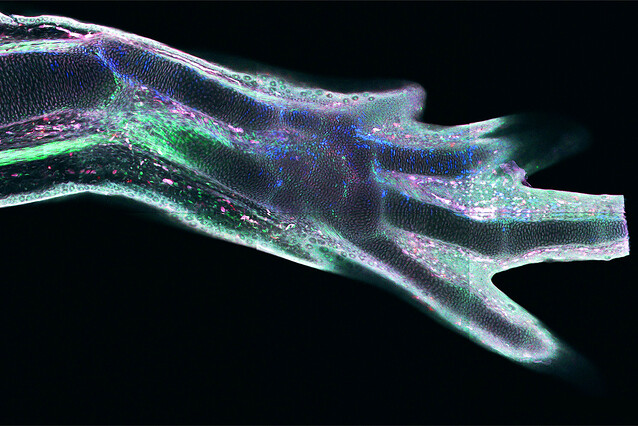Chromatin signals steer local programs for axolotl limb regrowth
The axolotl can regenerate fully functional limbs and organs by using positional information encoded in its cells. Elly Tanaka’s lab has now shown that chromatin stop signals on genes guide the correct regeneration program, ensuring that body parts regrow normally depending on where the limb was lost. The findings were published in the journal Developmental Cell.
The salamander species axolotl (Ambystoma mexicanum) can regenerate limbs and many of its organs. To achieve this feat, the regenerating structures must “know” their position within the axolotl body: when an axolotl loses a limb at the level of its hand, it regenerates only the hand; however, when it loses the limb at the level of its shoulder, the animal regrows the upper and lower arm as well as the hand. But how do cells know where they are located and which body parts to regrow? In their new study, scientists from the lab of Elly Tanaka, now at the Institute of Molecular Biotechnology (IMBA)—and at the IMP until last month—show that stop signals on genes allow axolotl cells to trigger the regeneration program appropriate for a specific location.
Cells in the axolotl limb not only know where they are located, but also “remember” this positional information when transplanted into a new environment: When hand cells are transplanted into the upper arm, they still only regenerate the hand. Therefore, the scientists asked how positional information is encoded in connective tissue cells before regeneration is triggered, and how the cells react once regeneration starts.
To gain a better understanding of how genes required for regeneration are controlled, the researchers focused on chromatin. Chromatin proteins associate with DNA to regulate the activity of genes, and differences in chromatin are responsible for the difference between cell types such as neurons and blood cells. Looking at chromatin in cells in the hand versus the upper arm, the researchers noted a striking difference, even when no regeneration was occurring: In the upper arm, genes that induce the formation of the hand bear the chromatin “stop” signals, while genes that induce the formation of the upper arm lack them.
When regeneration is triggered, these differences in chromatin are key for only regrowing the correct structures: In the upper arm, the strong stop signal on hand genes prevents the start of the “hand program”, and the upper arm regrows first. In the hand, where there are no stop signals, the “hand program” launches and the hand regrows. Meanwhile, the competition between genes ensures that hand genes block the growth of upper arm structures at the hand level. The findings contribute important insights on the molecular mechanisms of limb regeneration in axolotls generally.
Original Publication
A chromatin code for limb segment identity in axolotl limb regeneration. Akane Kawaguchi, Jingkui Wang, Dunja Knapp, Prayag Murawala, Sergej Nowoshilow Wouter Masselink, Yuka Taniguchi-Sugiura, Ji-Feng Fei, Elly M. Tanaka. Developmental Cell. DOI:https://doi.org/10.1016/j.devcel.2024.05.002
Further Reading
